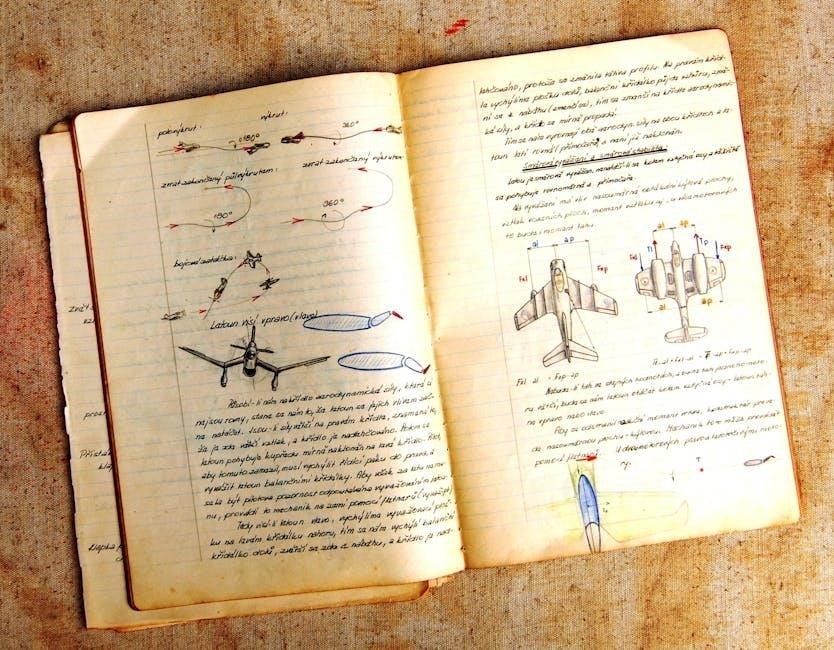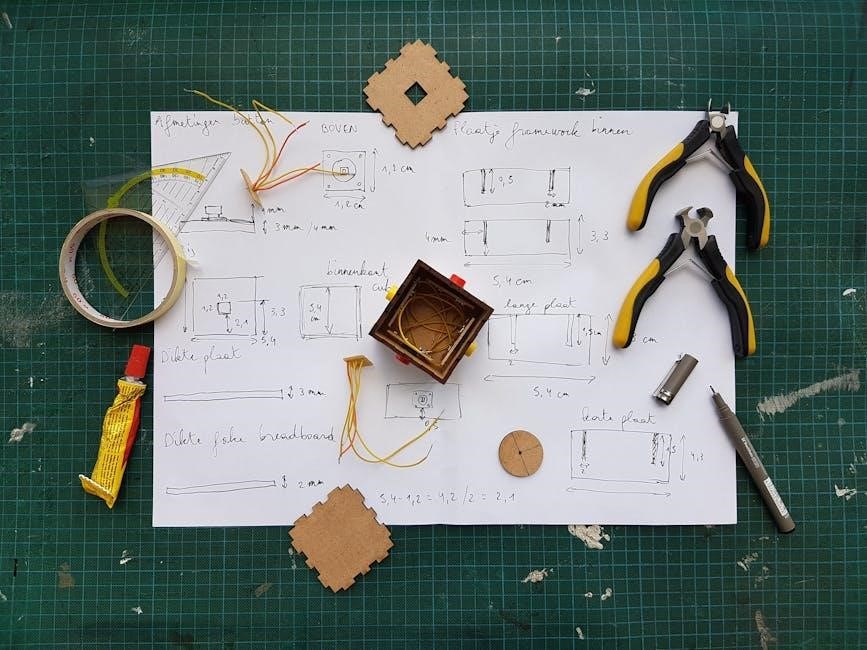Welcome to the Honeywell RM7800 Manual, your essential guide for understanding and working with the RM7800 series of microprocessor-based burner controls․ This manual is designed to assist technicians and installers in safely and effectively operating the RM7800, ensuring optimal performance and compliance with safety standards․
Overview of the Honeywell RM7800 Series
The Honeywell RM7800 series represents a line of microprocessor-based integrated burner controls designed for gas, oil, or combination fuel single-burner applications․ These modules are engineered for durability and reliability, operating in harsh environments with a temperature range of -40°C to 60°C and humidity up to 85%․ The RM7800 series is a solid-state replacement for older electromechanical controls like the R4140, offering advanced features such as flame supervision, self-diagnostics, and customizable settings․ This platform is ideal for industrial and commercial burner systems, ensuring precise control and safety in various combustion applications․
Importance of the Manual for Installation and Operation
This manual is crucial for the safe and effective installation, operation, and maintenance of the Honeywell RM7800 series․ It provides detailed instructions and guidelines to ensure compliance with safety standards and optimal system performance․ The manual covers essential topics such as wiring diagrams, conversion instructions, and troubleshooting, making it an indispensable resource for technicians and installers․ By following the manual’s recommendations, users can minimize risks, ensure reliable operation, and extend the lifespan of the burner control system․ Proper use of this manual is key to achieving efficient and secure combustion control in various industrial and commercial settings․

Features and Benefits of the Honeywell RM7800
The Honeywell RM7800 offers advanced features like customizable control, remote access, and diagnostics, ensuring efficient and reliable burner operation across gas, oil, or combination fuel applications․
Advanced Features for Customizable Control
The Honeywell RM7800 boasts advanced features for tailored control, including configurable settings, motion sensors, and customizable alerts; These features allow users to adapt the system to specific needs, ensuring precise operation and monitoring․ Remote access capabilities further enhance convenience, enabling adjustments and monitoring from a distance․ The RM7800’s microprocessor-based technology supports seamless integration with various fuel types and burner applications, providing a flexible and efficient solution for industrial and commercial environments․ These advanced features are designed to optimize performance, reduce downtime, and ensure safety across diverse operational conditions․
Microprocessor-Based Integrated Burner Control
The Honeywell RM7800 features a microprocessor-based integrated burner control system, designed for precise and efficient operation․ This advanced technology enables seamless control of gas, oil, or combination fuel burners, ensuring reliable performance․ The microprocessor handles complex functions like ignition timing, flame supervision, and safety protocols, making it a robust solution for industrial and commercial applications․ Its solid-state design replaces traditional electromechanical controls, offering enhanced durability and reduced maintenance․ The RM7800’s microprocessor-based system ensures accurate monitoring and control, providing a high level of operational reliability and safety in various burner configurations․
Compatibility with Gas, Oil, or Combination Fuel Applications
The Honeywell RM7800 is designed to work seamlessly with gas, oil, or combination fuel systems, offering versatility for diverse industrial and commercial applications․ Its advanced microprocessor-based control ensures reliable operation across different fuel types, providing consistent performance and safety․ This flexibility makes the RM7800 an ideal solution for single-burner applications requiring precise control․ Whether used with gas, oil, or a combination of fuels, the RM7800 adapts to meet the specific demands of each system, ensuring efficient and safe burner operation in various environments․

Technical Specifications of the Honeywell RM7800
The RM7800 operates in harsh conditions, with a temperature range of -40°C to 60°C and relative humidity up to 85%․ It supports microprocessor-based control for gas, oil, or combination fuels․

Operating Temperature Range and Environmental Conditions
The Honeywell RM7800 is designed to function reliably in harsh environments, with an operating temperature range of -40°C to 60°C․ It can tolerate relative humidity levels up to 85%, ensuring durability in various industrial settings․ The control’s robust construction allows it to perform consistently in extreme conditions, making it suitable for both indoor and outdoor installations․ Proper installation in accordance with environmental specifications is crucial to maintain optimal performance and longevity of the device․ These specifications ensure the RM7800 operates efficiently across diverse applications and climates without compromising safety or functionality․
Fuel Compatibility and Burner Applications
The Honeywell RM7800 is compatible with gas, oil, or combination fuel systems, making it versatile for various burner applications․ Its microprocessor-based design ensures precise control for single-burner setups, optimizing combustion efficiency and safety․ Designed for both gas and oil-fired systems, the RM7800 is ideal for industrial and commercial burner applications․ The control supports intermittent or continuous operation, adapting to different fuel types and burner configurations․ This flexibility allows it to be integrated into a wide range of heating systems, ensuring reliable performance and compliance with safety standards across diverse installations․ Its compatibility with multiple fuels makes it a robust solution for varied industrial needs․
Microprocessor and Relay Module Details
The Honeywell RM7800 features a microprocessor-based control system that enhances precision and reliability in burner operations․ The relay module is designed for solid-state performance, offering durable and efficient control of burner functions․ This advanced technology replaces traditional electromechanical controls, such as the R4140, with improved accuracy and reduced mechanical wear․ The microprocessor enables real-time monitoring and control, ensuring safe and efficient combustion․ The RM7800’s relay module is compatible with various burner configurations, making it adaptable to different industrial applications․ Its robust design ensures long-term reliability, while its microprocessor capabilities provide advanced diagnostics and operational insights․

Installation and Setup Instructions
Follow detailed wiring diagrams and conversion guides to install the RM7800․ Ensure proper mounting and connectivity for safe operation․ Refer to the manual for specific instructions․
Step-by-Step Installation Guide
The Honeywell RM7800 installation requires careful preparation․ Begin by ensuring the power supply is disconnected․ Mount the control module securely, following the manual’s specifications․ Connect the wiring according to the provided diagrams, ensuring all terminals are correctly matched․ If converting from an older model, refer to the conversion guide for compatibility details․ Once wired, test the system in a controlled environment to verify proper operation․ Always follow safety protocols and manufacturer guidelines to avoid potential hazards․ Proper installation ensures reliable performance and longevity of the RM7800 system․
Wiring Diagrams and Conversion Instructions
For proper installation, refer to the official Honeywell RM7800 wiring diagrams, ensuring all connections align with the terminal layout․ Use the provided color-coded guides to match wires accurately; When converting from older models like the R4140, follow the step-by-step conversion instructions to maintain compatibility․ Carefully remove existing connections and reconnect according to the new module’s specifications․ Verify each wire’s placement to avoid malfunctions․ After wiring, test the system to ensure correct operation․ Detailed conversion charts and diagrams are available in the manual or downloadable resources, facilitating a smooth transition to the advanced RM7800 system․
Mounting and Connectivity Options
The Honeywell RM7800 can be securely mounted on a flat surface using screws or clips to prevent vibration․ It also supports DIN rail mounting for convenient installation․ Connectivity options include standard terminal connections for wiring, ensuring reliable communication with other components․ Additional interfaces may be available for remote access and monitoring, enhancing system integration capabilities․ Always follow the manual’s guidelines for proper installation and connectivity to ensure optimal performance and safety․

Operation and Control of the RM7800
The RM7800 operates via a microprocessor, enabling customizable control of burner functions․ It supports multiple operation modes, including automatic and manual, with advanced flame supervision for safety․
Understanding the Control Panel and Display
The Honeywell RM7800 features an intuitive control panel and display designed for easy monitoring and operation․ The display provides real-time system status, first-out annunciation, and advanced diagnostics․ With a 2-row by 20-column interface, it offers clear visibility of operational data, enabling quick troubleshooting and adjustments․ The control panel includes buttons for navigating menus, adjusting settings, and accessing diagnostic features․ This user-friendly interface ensures seamless interaction, allowing technicians to monitor burner performance, adjust parameters, and address issues efficiently․ The display also supports local and remote annunciation, enhancing system monitoring capabilities for optimal control and safety․
Configuring Settings for Optimal Performance
Configuring the RM7800 involves setting parameters to match specific burner requirements․ The control panel allows users to adjust fuel type, ignition timing, and flame supervision settings․ Advanced features enable customization of alerts and remote access, ensuring tailored performance․ The microprocessor-based system provides precise control, optimizing burner operation for efficiency and safety․ Users can access diagnostic data to fine-tune settings, reducing downtime and enhancing reliability․ Proper configuration ensures compliance with safety standards and maximizes system longevity․
Operating Modes and Flame Supervision
The RM7800 offers multiple operating modes, including on/off and modulating control, to suit various burner applications․ Flame supervision is a critical safety feature, ensuring continuous monitoring of the flame’s presence and stability․ The microprocessor-based system provides advanced flame detection and response, halting operation if an unsafe condition is detected․
Diagnostic capabilities enable real-time monitoring and troubleshooting, while customizable alerts enhance operational safety․ The control seamlessly integrates with fuel systems, ensuring reliable performance across gas, oil, or combination fuel applications․ These features collectively ensure efficient and safe burner operation, adhering to industry standards and user preferences․

Safety Considerations and Precautions
Always follow proper installation and maintenance procedures to ensure safe operation․ Turn off power before servicing and verify system status regularly to prevent accidents․
General Safety Precautions for Installation
Always disconnect power before installing or servicing the RM7800 to prevent electrical shock․ Ensure the system is completely powered down and verify voltage absence․ Avoid contact with live circuits and wear appropriate protective gear․ Properly ground the equipment to prevent static discharge․ Use tools compatible with the device to avoid damage․ Follow all local safety codes and regulations․ Never bypass safety features or attempt unauthorized modifications․ Ensure all connections are secure and tightened correctly․ Keep the area well-ventilated and free from flammable materials․ Refer to the manual for specific precautions and guidelines to ensure safe installation and operation․ Failure to comply may result in injury or system damage․
Emergency Shutdown Procedures
In case of an emergency, immediately disconnect the power supply to the RM7800 system․ Activate the emergency stop switch if available․ Ensure all fuel supply lines are closed to prevent further ignition sources․ Ventilate the area to eliminate any flammable vapors․ Do not attempt to restart the system until it has been thoroughly inspected and deemed safe․ Always follow the specific shutdown procedures outlined in the manual for your particular installation․ If unsure, consult a qualified technician to avoid potential hazards․ Remember, prompt action is crucial to prevent accidents and ensure system integrity․
Troubleshooting Common Safety Issues
Regularly inspect the RM7800 system for worn or damaged components․ Check for loose electrical connections and ensure all sensors are functioning correctly․ If the flame supervision system indicates a fault, verify the flame detector’s cleanliness and alignment․ Address any gas or oil leaks promptly by shutting off the fuel supply․ Consult the manual for specific error codes and their solutions․ Perform routine diagnostics to identify potential issues before they escalate․ Always follow safety protocols when troubleshooting to prevent accidents․ If a problem persists, contact Honeywell’s technical support for professional assistance․ Early detection and resolution are key to maintaining a safe operating environment․

Maintenance and Diagnostics
Perform routine maintenance, including cleaning sensors and checking connections․ Use diagnostic tools to identify and resolve issues promptly for optimal performance and safety․
Regular Maintenance Requirements
Regular maintenance is crucial for optimal performance of the Honeywell RM7800․ Ensure sensors are clean and connections are secure․ Schedule periodic inspections of fuel systems and ignition components․ Replace worn or damaged parts promptly․ Use diagnostic tools to monitor system health and address issues early․ Check for firmware updates to ensure the latest features and improvements․ Perform routine cleaning of the control panel and internal components to prevent dust buildup․ Refer to the manual for specific maintenance schedules and procedures tailored to your application․ Proper upkeep ensures reliability, safety, and extended lifespan of the burner control system․
Advanced Diagnostic Features
The Honeywell RM7800 incorporates advanced diagnostic features to simplify troubleshooting and system monitoring․ The microprocessor-based design enables real-time monitoring of burner performance and fault detection․ The S7800A1142 KDM module provides detailed system status, first-out annunciation, and diagnostics through a 2-row by 20-column display․ This allows for quick identification of issues, reducing downtime․ The system also supports local/remote annunciation, ensuring comprehensive monitoring capabilities․ These diagnostic tools enable technicians to address problems efficiently, ensuring optimal burner operation and safety․ Regular use of these features helps maintain system reliability and performance over time․

Additional Resources and Support

Access downloadable PDF manuals, customer support, and technical assistance for the Honeywell RM7800․ These resources provide comprehensive guidance and troubleshooting help for optimal system performance․
Downloadable PDF Manuals and Guides
The Honeywell RM7800 manual is available as a downloadable PDF, offering detailed instructions for installation, operation, and troubleshooting․ This comprehensive guide covers technical specifications, safety precautions, and advanced features, ensuring users have all necessary information at their fingertips․ Additional resources include wiring diagrams and conversion guides for seamless integration with existing systems․ By accessing the PDF manual, users can explore configuration options, diagnostic tools, and maintenance schedules, enabling them to maximize the efficiency and longevity of their RM7800 burner control system․
Customer Support and Technical Assistance
Honeywell provides comprehensive customer support and technical assistance for the RM7800 series, ensuring users receive prompt help when needed․ Technical experts are available to address installation, operation, and troubleshooting inquiries․ Additionally, Honeywell offers online resources, including FAQs, troubleshooting guides, and repair information․ Users can access 24/7 support through phone, email, or online portals․ For complex issues, specialized technical teams are ready to assist, ensuring minimal downtime and optimal system performance․ Honeywell’s commitment to customer satisfaction ensures seamless support for the RM7800, helping users maintain efficiency and safety in their operations․
